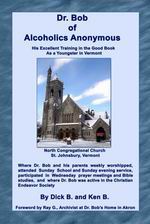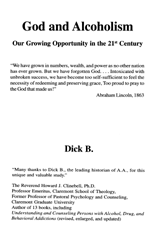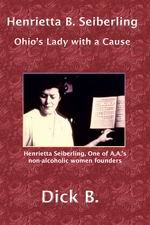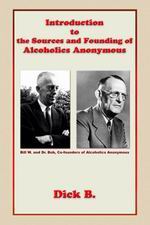Other Books Written by Dick B. that were Published
Dick’s books can be ordered from many major online book retailers.
CONTINUED – BOOKS 7 THRU 11
|
ISBN
1-885803-85-0  |
Dr. Bob of Alcoholics Anonymous
His Excellent Training in the Good Book As a Youngster in Vermont This title tells you about A.A. cofounder Dr. Bob’s “excellent training” in the “Good Book” as “a youngster.” It presents an in-depth exploration of the training Dr. Bob received during his boyhood years in St. Johnsbury, Vermont. You will see, from its documented details, that young Bob’s major Christian training—the training translated into the early A.A. spiritual recovery program in Akron—came from his parents, Walter P. and Susan H. Smith; North Congregational Church, St. Johnsbury; the Christian Endeavor Society of that church; and the rigorous requirements and studies at the famous St. Johnsbury Academy. The authors traveled to St. Johnsbury; visited principal buildings existing during Bob’s youth; interviewed the North Church pastor, the St. Johnsbury Academy archivist and the librarian, people at his boyhood home, and others. Then began their intensive research of the actual records, background books, photos, and communications. The bibliography will help readers to do likewise if they choose. More importantly, this title is a companion to a second “volume” comprising 20 resource binders and to a large number of books in the newly- founded Dr. Bob Core Library at North Congregational Church, St. Johnsbury, which houses extensive historical, biographical, educational, Christian, and other books, manuscripts, and photographs.
|
|
ISBN
1-885803-34-6  |
GOD AND ALCOHOLISM Dick B.’s 11 years of historical research have jump-started this compelling new theme: Take a specific look at Pioneer A.A.’s God-centered program in Akron. Then, at why they had to rely on the Creator. Then at what A.A. really spawned in the 20th Century, at the “nonsense gods” that have diverted this society from its primary purpose, and at the even greater need for help from God Almighty on the recovery scene today to restore success and assure a return to sound, faith-based, non-profit recovery.
|
|
ISBN
1-885803-22-2  |
GOOD MORNING!
Quiet Time, Morning Watch, Meditation, and Early A.A. (Second Edition) Did you know that the spiritual recovery program which produced such a high success rate in the 1930’s and early 1940’s was totally different from recovery programs today? Well it was! Spirituality back then meant dependence upon God the Creator. Dependence really meant establishing a relationship through the acceptance of Jesus Christ as one’s Lord and Savior. The growth part of the program had a great deal to do with Quiet Time–a Quiet Time that included Bible study, prayer, receiving revelation from God, and the use of devotional books and periodicals such as The Upper Room as ancillary study materials and as a spur to spending substantial time with God each morning. This worked! It can work today for those who wish to utilize the tools of early A.A. to achieve a recovery rate somewhere near the seventy-five to ninety-three percent rate achieved in Akron and Cleveland. Where did Quiet Time come from? Where did the Morning Watch fit into the picture? What did meditation in God’s Word and communion with Him involve? How does this differ from today’s one-page “meditations” and “reflections?” What can knowledge of this early history do for alcoholics and other addicts, treatment and recovery programs, clergy and churches? Active AA and recovered alcoholic Dick B. has spent eight years digging out the facts and presents them here so others may benefit.
|
|
ISBN
1-0885803-44-3  |
HENRIETTA B. SEIBERLING
Ohio’s Lady with a Cause (Second, Revised Edition) This is the first full and accurate account of A.A.’s real beginnings in Akron, Ohio. And a good deal more. Never before has there been gathered in one book the real events that lead to the actual beginning of Alcoholics Anonymous on Mother’s Day, 1939, when Henrietta Seiberling introduced A.A.’s two founders to each other at her home at the Gate Lodge of the Stan Hywet Hall and Gardens, a huge mansion built by rubber industry tycoon Frank A. Seiberling in 1910 when his Goodyear Tire and Rubber Company was making great strides. The following subtitle gives you a picture of the scope of this little book’s contents: “The Story of Akron’s Pioneer A.A. Christian Fellowship, Its Oxford Group Encounters, and a Non-alcoholic Woman’s Role in Helping Found Early A.A.’s Unique Spiritual Program for Curing Alcoholics.” To set the scene, there is a brief sketch of Henrietta’s own beginnings, beliefs, problems, and life. Next comes a brand new over-view of A.A.’s origins. First is the distorted historical picture today with confusion over the date of founding, confusion over which was the “original” A.A. program, and the tangled sources involved in the founding. Second, there is a succinct, but careful review of the six major religious roots that author Dick B. has unearthed and discussed in many previous titles. Then for the history-hungry reader, there is a new and important discussion of less mentioned, less researched, yet significant roots: (1) Carl Jung and his books. (2) William James and his books. (3) The “New Thought” writings that crept into Bill Wilson’s Big Book via Christian Science, Ralph Waldo Trine, Emmanuel writers, Emmet Fox, and others—with adequate contrast of these ideas with those Biblical Christian principles and practices in Akron. (4) The suspected impact of the United Christian Endeavor Society of Dr. Bob’s youth and the current research on this matter. And then a call for less restrictive histories, biographies, and literature in those currently telling the 12 Step stories and history. Pinpointing many unknown or ignored facts about Henrietta’s special role as a non-alcoholic woman who helped found A.A., there are two pages of staccato bullet point one-liners that will assist you in remembering who she was and what she did. Many A.A. people and histories give undue credit to the Oxford Group influence on A.A. Mostly as a jumping-off place for criticizing this group. But the real facts will surprise you. This book tells how the Oxford Group entered the Akron scene via Harvey Firestone, Bud Firestone, Rev. Sam Shoemaker, and Jim Newton. Then in a new and refreshing account, there is the story of what Henrietta Seiberling did from that point on. She was able to utilize the famous 1933 Akron Oxford Group extravaganza in her unrelenting efforts to help Dr. Bob quit drinking and bring relief to his wife Anne. Notions that the Oxford Group, the Bible, church, prayer, God, and religion failed are positively and authoritatively dispelled by showing that it was Dr. Bob’s own insistent refusal to resist temptation and abstain that were the problem. Then Henrietta’s revelation about Bob, her group’s prayer for and with Bob, and the miraculous founding events that followed almost immediately. These facts will give you a new perspective on the prayers, the power of the Creator, and Dr. Bob’s own believing to set the Akron miracle and founding in motion. One more time, author Dick B. shows the sharp contrast between the Akron Christian Fellowship program that was developed by Bob and Bill primarily in the summer of 1935 and the far less effective Oxford Group experiences before and after in the New York arena. The difference between Oxford Group practices and objectives and those of Wilson in New York are highlighted. And then, once again by this author, there is a careful review of the seven very specific ingredients that made the Akron Christian Fellowship successful in its program for the spiritual cure of alcoholism. Though some are newly critical of, and distorting the facts about the importance of James, the Sermon on the Mount, and 1 Corinthians 13, the detours are re-routed into a better understanding of what Akron was really focused on. This portion concludes with a very real picture of the “real” “original” A.A. program and the need for honesty about it. It tells what that program wasn’t and then what it was. And the discussion is sure to drive today’s history revisionists, New Thought proponents, and universalism advocates straight up a tree. For the truth will make you free, but it will not set well with some of today’s analysts. There is a brief chapter on A.A.’s exit from the Oxford Group. First in New York by the Wilson’s. Then in Cleveland by Clarence Snyder et. al. And finally by most of the remaining Akron pioneers in the early 1940’s. There is a thorough discussion of the Oxford Group’s very limited impact on A.A., except through the teachings of Rev. Sam Shoemaker and the resultant language of the 12 Steps that Bill Wilson wrote. The book concludes with a short page, titled “Let go and Let God.” And we will let the reader learn for himself or herself about that. There is a selected, but adequate bibliography that was used by the author and will help you do your own verification.
|
|
ISBN
1-885803-86-9  |
INTRODUCTION TO THE SOURCES AND FOUNDING OF ALCOHOLICS ANONYMOUS
Dick B. has long awaited the opportunity to provide a written introduction to the history of Alcoholics Anonymous that could be used by individual Twelve Step people, sponsors, facilitators, therapists, writers, historians, treatment centers, and interested agencies to include a correct 12 Step history in their own programs. And this is the title for just that! There are five major epochs in the spiritual recovery program that is embodied in Alcoholics Anonymous itself. Each is covered in this introduction; and the points here provide an umbrella introduction to the variant sources, attitudes, strains, divergences, and language in programs today. 1. The Akron Genesis Period – Bob’s childhood to prayers for him in Akron in 1935. 2. The New York Conversion Period – Calvary Mission to Bill’s Akron visit. 3. The Original A.A. Program that Bill and Bob developed from Akron Bible roots between 1935 and 1938. 4. The Works Publishing Co. Program Bill fashioned and embodied in A.A.’s basic text of 1939. 5. The Reshaping of the Wilson Program between 1939 and 1955. Learn these stages of Twelve Step program development, and you’ll know our real A.A. sources and understand its original program, the Big Book changes, and the enormous divergences that began just before Bill’s years of severe depression. You’ll be able to describe our history as it is and was, not as some have reshaped it to satisfy individual promotional, universalist, secularist, or revisionist agenda theories. . |
